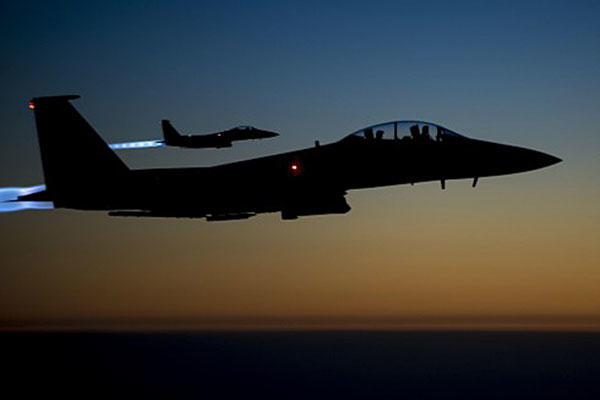The U.S. air campaign against the Islamic State in Iraq and Syria has killed at least 16 civilians and wounded nine to date despite the strict rules of engagement for U.S. pilots, according to U.S. Central Command.
Air Force Col. Pat Ryder, a CentCom spokesman, said the low civilian death toll from more than 9,800 airstrikes that dropped more than 35,000 precision munitions was a "testament to our aviators" and their skills in using all-precision munitions to keep so-called "collateral damage" to a minimum.
In a telephone briefing Friday to the Pentagon, Ryder said that "mitigating civilian casualties has been a key component" in the fight against the Islamic State of Iraq and Syria (ISIS) but "we also cannot guarantee zero civilian casualties."
"We deeply regret the unintentional loss of life and injuries resulting from those strikes and express our deepest sympathies to the victims' families and those affected," Ryder said. He also said that some of the casualties were attributable to the "cowardly behavior" of ISIS fighter in hiding among civilian populations.
At times, the perceived gain from striking an ISIS target must be weighed against the "acceptable risk" that civilians will be killed as a result, according to U.S. military officials.
On Wednesday, Army Col. Steve Warren, a spokesman for Combined Joint Task Force-Operation Inherent Resolve, said that the decision was made on Monday to bomb a building in Mosul that ISIS used to distribute cash despite the likelihood that civilians would be killed or injured.
As part of Ryder's briefing, CentCom released the results of five assessments of allegations that civilians were killed or injured in airstrikes from July 4 to July 17 last year. CentCom used the term ISIL, another acronym for ISIS:
-- On July 4, 2015, near Ar Raqqa, Syria, during strikes against 16 ISIL bridges, it was assessed one civilian in a truck with a trailer was likely killed.
-- On July 7, 2015, near Ar Raqqah, Syria, during strikes against ISIL fighters, it was assessed that a civilian was injured by a secondary explosion and flying debris from the initial strike.
-- On July 8, 2015, near Sarmada, Syria, during a strike against a vehicle carrying Khorasan Group Leader Muhsin al-Fadhli, it was assessed two civilians on a motorcycle were likely injured.
-- On July 11, 2015, near Ar Raqqah, Syria, during counter-ISIL strikes it was assessed one civilian was killed. A post-strike review revealed a secondary explosion from a vehicle crossing a bridge nearby the intended target; this explosion resulted in one civilian likely killed.
-- On July 17, 2015, near Mosul, Iraq, during strikes against ISIL fighters traveling in a vehicle, it was assessed one civilian was injured.
Ryder said that thus far CentCom has received 120 allegations that a U.S. airstrike caused civilian casualties. After review, 67 of the 120 allegations were "deemed not credible," he said. Centcom currently has 14 allegations under review. Of those 14, nine were pending credibility assessments and five were under active investigation, Ryder said.
Defense Secretary Ashton Carter has said repeatedly in recent weeks that the campaign against ISIS will be accelerated but there were no current plans to change the rules of engagement for airstrikes, Ryder said. However, "we're continually looking at our processes, continually finding ways to hit the enemy with minimal civilian casualties," he said.
Critics of the Obama administration have frequently called for relaxing the rules, charging that as many as three-quarters of sorties flown by U.S. warplanes return to base without dropping munitions for fear of collateral damage. Sen. John McCain, R-Ariz., the chairman of the Senate Armed Services Committee (SASC), has also called for placing U.S. combat air controllers on the frontlines to guide airstrikes.
Last July, Army Gen. Martin Dempsey, then-chairman of the Joint Chiefs of Staff, told a SASC hearing that the majority of combat air missions over Iraq returned without dropping bombs.
"At a similar period in the Afghanistan conflict in 2012, the number of aircraft that returned with their ordnance because there were not targets available on the ground was 83 percent," Dempsey said. "It's 65 percent in Iraq right now." However, Air Force and other U.S. military officials have said that the percentage of planes dropping munitions has increased since last summer.
Republican presidential contenders have been particularly critical of the Obama administration in calling for the rules of engagement to be relaxed.
Last month, former Gov. Jeb Bush, R-Fla., called on Obama last month to "take the lawyers off the war fighters' backs and let them go do the job."
"Up until recently, 75 percent of all the sorties that left the base came back without dropping their ordnances, because there was such a concern about making sure that there were no civilian casualties," Bush said on ABC-TV's "This Week" program.
Bush's numbers appeared to be at best outdated. The Air Force later told Politifact Florida that about 50 percent of sorties dropped munitions in July and the number had risen to 65 percent in November.
-- Richard Sisk can be reached at Richard.Sisk@Military.com.






























